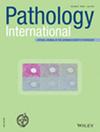胃腺癌的分子分类和瘤内异质性。
IF 2.5
4区 医学
Q2 PATHOLOGY
引用次数: 0
摘要
胃癌经常具有惊人的组织学复杂性和多样性,病灶之间以及单个病灶内部的组织学复杂性和多样性分别被称为瘤间异质性和瘤内异质性。世界卫生组织最新的肿瘤分类为胃上皮肿瘤指定了 30 多个组织学亚型,为胃腺癌(GAD)指定了 12 个亚型。与此同时,全基因组分析的最新进展为 GAD 的组织学分类提供了分子方面的依据,从而揭示了这些组织学亚型背后的不同分子特征。此外,综合分子图谱知识的不断积累也促成了 GAD 分子分类的建立,这些分类通常与治疗和预后的临床生物标志物相关联。然而,我们对 GAD 分子图谱的了解大多基于肿瘤间的异质性,而肿瘤内异质性的分子图谱尚待确定。本综述从病理诊断的角度介绍了最近确立的 GAD 分子分类,并结合瘤内异质性进行了讨论。本文章由计算机程序翻译,如有差异,请以英文原文为准。
Molecular classification and intratumoral heterogeneity of gastric adenocarcinoma.
Gastric cancers frequently harbor striking histological complexity and diversity between lesions as well as within single lesions, known as inter- and intratumoral heterogeneity, respectively. The latest World Health Organization Classification of Tumors designated more than 30 histological subtypes for gastric epithelial tumors, assigning 12 subtypes for gastric adenocarcinoma (GAD). Meanwhile, recent advances in genome-wide analyses have provided molecular aspects to the histological classification of GAD, and consequently revealed different molecular traits underlying these histological subtypes. Moreover, accumulating knowledge of comprehensive molecular profiles has led to establishing molecular classifications of GAD, which are often associated with clinical biomarkers for therapeutics and prognosis. However, most of our knowledge of GAD molecular profiles is based on inter-tumoral heterogeneity, and the molecular profiles underlying intratumoral heterogeneity are yet to be determined. In this review, recently established molecular classifications of GAD are introduced in the aspect of pathological diagnosis and are discussed in the context of intratumoral heterogeneity.
求助全文
通过发布文献求助,成功后即可免费获取论文全文。
去求助
来源期刊

Pathology International
医学-病理学
CiteScore
4.50
自引率
4.50%
发文量
102
审稿时长
12 months
期刊介绍:
Pathology International is the official English journal of the Japanese Society of Pathology, publishing articles of excellence in human and experimental pathology. The Journal focuses on the morphological study of the disease process and/or mechanisms. For human pathology, morphological investigation receives priority but manuscripts describing the result of any ancillary methods (cellular, chemical, immunological and molecular biological) that complement the morphology are accepted. Manuscript on experimental pathology that approach pathologenesis or mechanisms of disease processes are expected to report on the data obtained from models using cellular, biochemical, molecular biological, animal, immunological or other methods in conjunction with morphology. Manuscripts that report data on laboratory medicine (clinical pathology) without significant morphological contribution are not accepted.
 求助内容:
求助内容: 应助结果提醒方式:
应助结果提醒方式:


